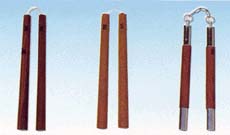|
|||
|
| -Countries |
| -Dictionary |
| -Federations |
| -M.A. Timeline |
| -Number System |
| -Styles |
| -Weapons |
| -Who's Who |
| -Updates |
| -Credits |
| -Stats |
| -Webmaster |
| Nunchaku History
In the Okinawan language, "Nun" means Horse. "Chiyaku" means Bridle. The original Nunchiyaku was a horse bridle. The design was two crescent shaped pieces of wood with ropes and cords that laced them onto the horse's muzzle. They had several sets of holes for this as well as for the riders reins. The style of these tools, turned weapons was mostly used on the horses that pulled carts and wagons and must have changed over the years as horse harnesses improved. The nunchaku stick is divided into 3 parts: the upper part (jokon-bu), the middle part (chukon-bu) and the lower-part (kikon-bu). The top of the stick is called kontoh and the rope passes through the hole (ana). The bottom of the nunchaku is called kontei. Also called "Sosetsu Kon", Nunchaku is a pair of wooden sticks, usually made of oak, tied together at one end by two strings. The art of Nunchaku was developed for self-defense. Easily concealed, similar weapons are still used today in guerrilla war in Korea and around Southeast Asian countries. |


 It
is thought that women invented Nunchaku to defend themselves
after Satsuma's subjugation of the Ryukyu Kingdom about 380
years ago. The idea of making this weapon originated with the
tool, which peels off the bark of Abaca (banana tree) for weaving.
However, in Fuzhou China, there was a weapon called "Nisetsu
Kon" or "Ryosetsu Kon" but pronounced "Nunchaku"
in dialect. Its technique has a long history and is similar
to Sansetsu Kon. Therefore, this Nunchaku jutsu seems to be
influenced from Fuzhou China.
It
is thought that women invented Nunchaku to defend themselves
after Satsuma's subjugation of the Ryukyu Kingdom about 380
years ago. The idea of making this weapon originated with the
tool, which peels off the bark of Abaca (banana tree) for weaving.
However, in Fuzhou China, there was a weapon called "Nisetsu
Kon" or "Ryosetsu Kon" but pronounced "Nunchaku"
in dialect. Its technique has a long history and is similar
to Sansetsu Kon. Therefore, this Nunchaku jutsu seems to be
influenced from Fuzhou China.